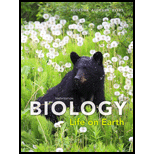
Concept explainers
DNA consists of subunits called_________. Each subunit consists of three parts:________,________, and_________.
To review:
The given blank space in the statement, “deoxyribonucleic acid (DNA) consists of subunits called ______. Each subunit consists of three parts: ____, _____, and _____.
Introduction:
DNA is a molecule which carries of genetic information in all living organisms except few viruses. DNA is a double helix structure formed by base pairs attached to a sugar-phosphate backbone. DNA is wrapped around a protein complex known as histones which further forms chromatin. This complex and organized structure is as a nucleosome in a eukaryotic cell.
Explanation of Solution
Nucleotide: Nucleotides are those organic biomolecules which act as a monomer for building up a long chain of DNA. It is a building block of nucleic acids. Nucleotide is composed of three subunits, namely, a sugar (pentose sugar), nitrogenous bases, and a phosphate group. When a nucleoside attaches with a phosphate group it then forms a nucleotide.
In case of ribonucleic acid (RNA), the pentose sugar is a ribose sugar while in case of DNA sugar is deoxyribose. The pentose sugar structurally lacks an oxygen atom from its two carbon position, thus named as deoxyribose.
Phosphate group: This group is chemically derived from phosphoric acid. When attached to the pentose sugar form a nucleotide. The linkage between the two nucleotides is helped by the phosphate group via a phosphodiester linkage.
Bases: Nitrogenous bases consist of nitrogen, carbon, and hydrogen in their homocyclic and heterocyclic rings. There exist five types of bases: adenine, thymine, guanine, cytosine, and uracil (in case of RNA). They form a strand in a double-helical structure of DNA. Their stability is directed by hydrogen bondings.
DNA consists of subunits called nucleotide. Each subunit consists of three parts: pentose sugar, a phosphate group, and nitrogenous bases.
Want to see more full solutions like this?
Chapter 11 Solutions
Biology: Life on Earth
- What symbolic and cultural behaviors are evident in the archaeological record and associated with Neandertals and anatomically modern humans in Europe beginning around 35,000 yBP (during the Upper Paleolithic)?arrow_forwardDescribe three cranial and postcranial features of Neanderthals skeletons that are likely adaptation to the cold climates of Upper Pleistocene Europe and explain how they are adaptations to a cold climate.arrow_forwardBiology Questionarrow_forward
- ✓ Details Draw a protein that is embedded in a membrane (a transmembrane protein), label the lipid bilayer and the protein. Identify the areas of the lipid bilayer that are hydrophobic and hydrophilic. Draw a membrane with two transporters: a proton pump transporter that uses ATP to generate a proton gradient, and a second transporter that moves glucose by secondary active transport (cartoon-like is ok). It will be important to show protons moving in the correct direction, and that the transporter that is powered by secondary active transport is logically related to the proton pump.arrow_forwarddrawing chemical structure of ATP. please draw in and label whats asked. Thank you.arrow_forwardOutline the negative feedback loop that allows us to maintain a healthy water concentration in our blood. You may use diagram if you wisharrow_forward
- Give examples of fat soluble and non-fat soluble hormonesarrow_forwardJust click view full document and register so you can see the whole document. how do i access this. following from the previous question; https://www.bartleby.com/questions-and-answers/hi-hi-with-this-unit-assessment-psy4406-tp4-report-assessment-material-case-stydu-ms-alecia-moore.-o/5e09906a-5101-4297-a8f7-49449b0bb5a7. on Google this image comes up and i have signed/ payed for the service and unable to access the full document. are you able to copy and past to this response. please see the screenshot from google page. unfortunality its not allowing me attch the image can you please show me the mathmetic calculation/ workout for the reult sectionarrow_forwardIn tabular form, differentiate between reversible and irreversible cell injury.arrow_forward
 Human Heredity: Principles and Issues (MindTap Co...BiologyISBN:9781305251052Author:Michael CummingsPublisher:Cengage Learning
Human Heredity: Principles and Issues (MindTap Co...BiologyISBN:9781305251052Author:Michael CummingsPublisher:Cengage Learning Human Biology (MindTap Course List)BiologyISBN:9781305112100Author:Cecie Starr, Beverly McMillanPublisher:Cengage Learning
Human Biology (MindTap Course List)BiologyISBN:9781305112100Author:Cecie Starr, Beverly McMillanPublisher:Cengage Learning Biology Today and Tomorrow without Physiology (Mi...BiologyISBN:9781305117396Author:Cecie Starr, Christine Evers, Lisa StarrPublisher:Cengage Learning
Biology Today and Tomorrow without Physiology (Mi...BiologyISBN:9781305117396Author:Cecie Starr, Christine Evers, Lisa StarrPublisher:Cengage Learning Concepts of BiologyBiologyISBN:9781938168116Author:Samantha Fowler, Rebecca Roush, James WisePublisher:OpenStax College
Concepts of BiologyBiologyISBN:9781938168116Author:Samantha Fowler, Rebecca Roush, James WisePublisher:OpenStax College





